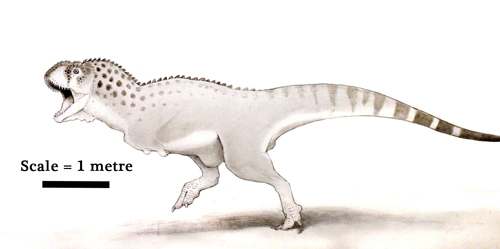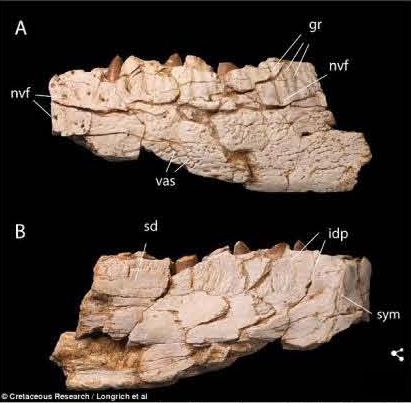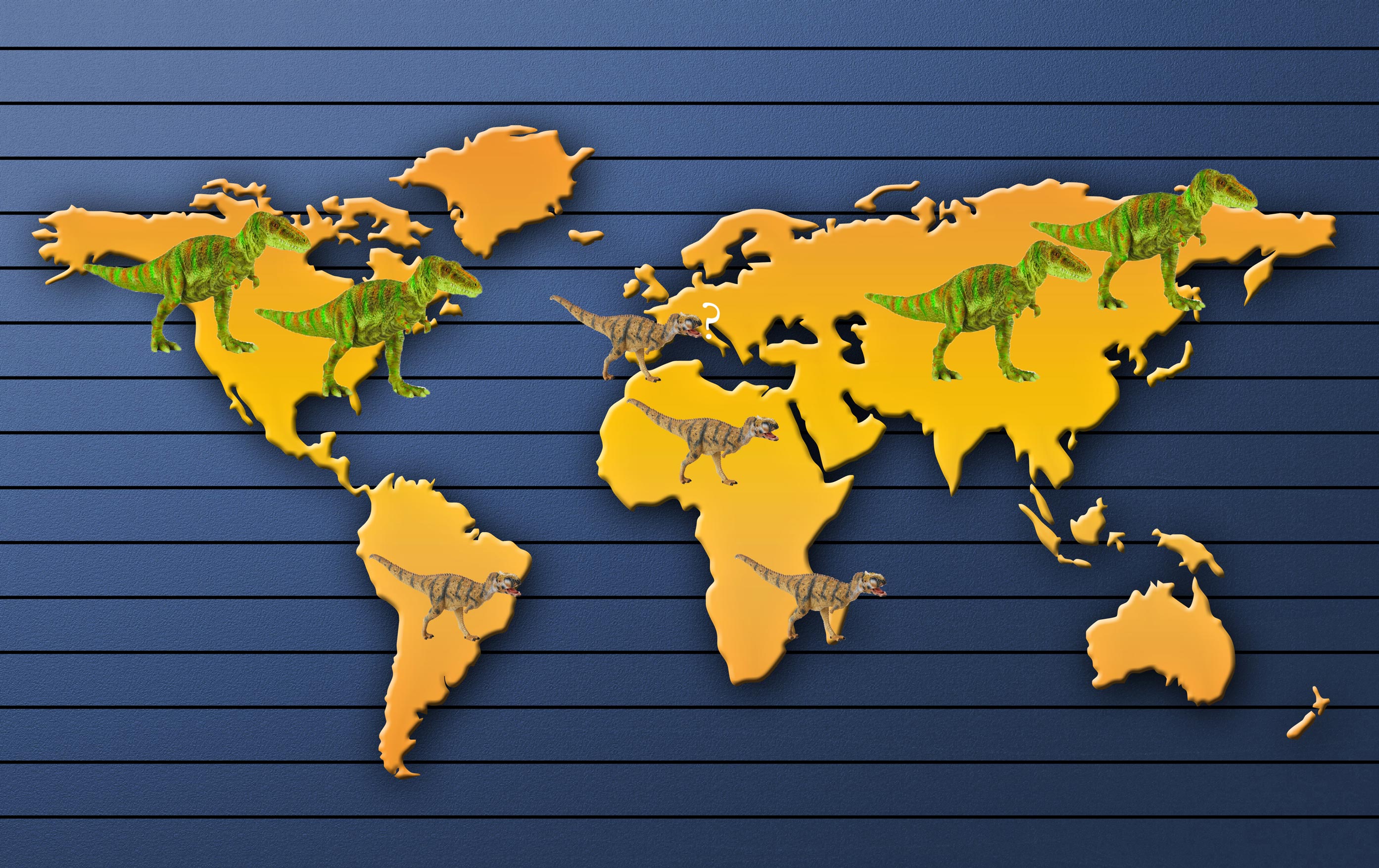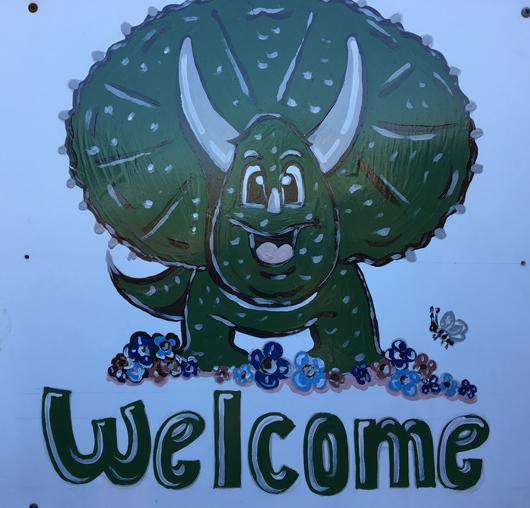Chenanisaurus barbaricus – Substantial Abelisaurid from Late Cretaceous Morocco
One of the last types of dinosaur to have existed in north Africa has been described in a new scientific paper published in the journal “Cretaceous Research”. A fragment of jaw bone (dentary) and isolated teeth discovered in a phosphate mine at Sidi Chennane in the Oulad Abdoun Basin, (Morocco), has enabled scientists to identify a new species of abelisaurid. The dinosaur, named Chenanisaurus barbaricus may belong to an as-yet undescribed family of Abelisaurs unique to Africa.
An Illustration of the Late Cretaceous Abelisaurid Chenanisaurus barbaricus

An illustration of Chenanisaurus barbaricus.
Picture credit: University of Bath with additional annotation by Everything Dinosaur
A Blunt Snout with an Unusually Short and Robust Jaw
Analysis of the fragment of dentary, along with the associated teeth, indicates that the jaw of this dinosaur was very short, even for an abelisaurid. The morphology of the jaw is described as being even more extreme than that seen in other abelisaurids such as Carnotaurus. Extensive wear on the teeth suggests hypercarnivory (diet consisting of more than 70 percent meat), Chenanisaurus was around 7-8 metres in length and it may have been an apex predator within the Late Cretaceous ecosystem.
A Photograph Showing Two Views of the Jaw Fragment

Jaw fragment fossil (labial and buccal view).
Picture credit: University of Bath
Marine Deposits from a Phosphate Mine
Lead author of the scientific paper, Dr Nick Longrich (Milner Centre for Evolution at the University of Bath), along with colleagues from Morocco, France, and Spain studied the jaw fossil and teeth that had been found in 66-million-year-old strata in a phosphate mine located in northern Morocco. Dinosaur fossils from the end of the Cretaceous (Maastrichtian faunal stage) are exceptionally rare in north Africa. Rising sea levels had isolated Africa as the super-continent of Gondwana continued to break up and from about 95 million years onwards, much of the former terrestrial habitat of the Dinosauria in north Africa was lost to the sea.
Commenting on the rarity of the fossil find, Dr Longrich stated:
“This find was unusual because it’s a dinosaur from marine rocks – it’s a bit like hunting for fossil whales, and finding a fossil lion. It’s an incredibly rare find – almost like winning the lottery. But the phosphate mines are so rich, it’s like buying a million lottery tickets, so we actually have a chance to find rare dinosaurs like this one.”
Chenanisaurus barbaricus – Confirming a Distinct African Terrestrial Fauna
Not only was Chenanisaurus barbaricus one of the last dinosaurs to roam our planet, its discovery supports the idea of a distinct north African terrestrial fauna towards the end of the Age of Dinosaurs. During the Maastrichtian faunal stage of the Late Cretaceous, horned dinosaurs and hadrosaurids were the most common and specious large, plant-eating dinosaurs in North America and Asia, whereas a different group of dinosaurs dominated terrestrial ecosystems in South America, India and Madagascar (Titanosauriformes and abelisaurids). In North America and Asia, the dominant, apex predators were Tyrannosaurs.
In 2004, a paper published in the “Journal of African Earth Studies”, provided details of a right hindlimb (femur, tibia and fibula), that had been found in phosphate deposits near the town of Khouribga (central Morocco). Just like Chenanisaurus, these fossils date from approximately 66 million years ago and were also found in marine rocks.
Team members at Everything Dinosaur are not aware of a new genus having been established as a result of the discovery of the leg bones, but their presence in the rocks does indicate that titanosaurids survived in north Africa until the very end of the Cretaceous. These fossils along with the Chenanisaurus material suggests the persistence of a classic Gondwanan abelisaurid/titanosaurid fauna in mainland Africa right up to end- Cretaceous extinction event.
Tyrannosaurid versus Abelisaurid Distribution

Tyrannosaurid versus abelisaurid distribution. Picture credit: Everything Dinosaur.
Picture credit: Everything Dinosaur
Key
Tyrannosaurids = green
Abelisaurids = brown
The picture above shows a general distribution of apex predatory dinosaurs in the Late Cretaceous, with the exception of southern Europe, tyrannosaurids dominated the apex predator positions in Laurasia, whilst the abelisaurids dominated in the regions that made up Gondwana.
Phylogenetic Analysis
Phylogenetic analysis undertaken by the research team suggests that Chenanisaurus may represent a lineage of abelisaurids that is distinct from those previously described from the latest Cretaceous of South America, Indo-Madagascar, and Europe, consistent with the hypothesis that the fragmentation of Gondwana led to the evolution of endemic dinosaur faunas during the Late Cretaceous.
Dr Longrich added:
“We have virtually no dinosaur fossils from this time period in Morocco, it may even be the first dinosaur named from the end-Cretaceous of Africa. It’s also one of the last dinosaurs in Africa before the mass extinction that wiped out the dinosaurs. It is an exciting find because it shows just how different the fauna was in the Southern Hemisphere at this time.”
Visit Everything Dinosaur’s website: Everything Dinosaur.





